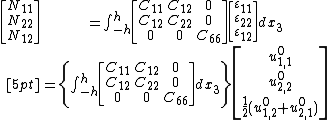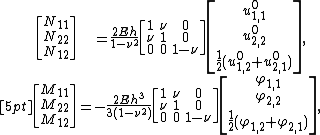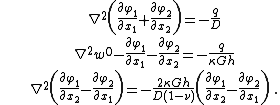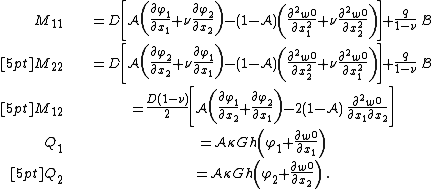- Mindlin theory Assumed displacement field Strain-displacement relations Equilibrium equations Boundary conditions Stress–strain relations
- Mindlin theory for isotropic plates Constitutive relations Governing equations
- Relationship to Reissner theory
- Relationship to Kirchhoff–Love theory
- References
- See also
The Mindlin–Reissner theory of plates is an extension of Kirchhoff–Love plate theory that takes into account shear deformations through-the-thickness of a plate. The theory was proposed in 1951 by Raymond Mindlin.[1] A similar, but not identical, theory had been proposed earlier by Eric Reissner in 1945.[2] Both theories are intended for thick plates in which the normal to the mid-surface remains straight but not necessarily perpendicular to the mid-surface. The Mindlin–Reissner theory is used to calculate the deformations and stresses in a plate whose thickness is of the order of one tenth the planar dimensions while the Kirchhoff–Love theory is applicable to thinner plates.
The form of Mindlin–Reissner plate theory that is most commonly used is actually due to Mindlin and is more properly called Mindlin plate theory.[3] The Reissner theory is slightly different. Both theories include in-plane shear strains and both are extensions of Kirchhoff–Love plate theory incorporating first-order shear effects.
Mindlin's theory assumes that there is a linear variation of displacement across the plate thickness but that the plate thickness does not change during deformation. An additional assumption is that the normal stress through the thickness is ignored; an assumption which is also called the plane stress condition. On the other hand, Reissner's theory assumes that the bending stress is linear while the shear stress is quadratic through the
thickness of the plate. This leads to a situation where the displacement through-the-thickness is not necessarily linear and where the plate thickness may change during deformation. Therefore, Reissner's theory does not invoke the plane stress condition.
The Mindlin–Reissner theory is often called the first-order shear deformation theory of plates. Since a first-order shear deformation theory implies a linear displacement variation through the thickness, it is incompatible with Reissner's plate theory.
Mindlin theory
Mindlin's theory was originally derived for isotropic plates using equilibrium considerations. A more general version of the theory based on energy considerations is discussed here.[4]
Assumed displacement field
The Mindlin hypothesis implies that the displacements in the plate have the form
where  and
and  are the Cartesian coordinates on the mid-surface of the undeformed plate and
are the Cartesian coordinates on the mid-surface of the undeformed plate and  is the coordinate for the thickness direction,
is the coordinate for the thickness direction,  are the in-plane displacements of the mid-surface,
are the in-plane displacements of the mid-surface,
 is the displacement of the mid-surface in the
is the displacement of the mid-surface in the  direction,
direction,  and
and  designate the angles which the normal to the mid-surface makes with the
designate the angles which the normal to the mid-surface makes with the  axis. Unlike Kirchhoff–Love plate theory where
axis. Unlike Kirchhoff–Love plate theory where  are directly related to
are directly related to  , Mindlin's theory requires that
, Mindlin's theory requires that  and
and  .
.
Strain-displacement relations
Depending on the amount of rotation of the plate normals two different approximations for the strains can be derived from the basic kinematic assumptions.
For small strains and small rotations the strain–displacement relations for Mindlin–Reissner plates are
The shear strain, and hence the shear stress, across the thickness of the plate is not neglected in this theory. However, the shear strain is constant across the thickness of the plate. This cannot be accurate since the shear stress is known to be parabolic even for simple plate geometries. To account for the inaccuracy in the shear strain, a shear correction factor ( ) is applied so that the correct amount of internal energy is predicted by the theory. Then
) is applied so that the correct amount of internal energy is predicted by the theory. Then
Equilibrium equations
The equilibrium equations of a Mindlin–Reissner plate for small strains and small rotations have the form
where  is an applied out-of-plane load, the in-plane stress resultants are defined as
is an applied out-of-plane load, the in-plane stress resultants are defined as
the moment resultants are defined as
and the shear resultants are defined as
| Derivation of equilibrium equations |
|---|
Boundary conditions
The boundary conditions are indicated by the boundary terms in the principle of virtual work.
If the only external force is a vertical force on the top surface of the plate, the boundary conditions are
Stress–strain relations
The stress–strain relations for a linear elastic Mindlin–Reissner plate are given by
Since  does not appear in the equilibrium equations it is implicitly assumed that it does not have any effect on the momentum balance and is neglected. This assumption is also called the plane stress assumption. The remaining stress–strain relations for an orthotropic material, in matrix form, can be written as
does not appear in the equilibrium equations it is implicitly assumed that it does not have any effect on the momentum balance and is neglected. This assumption is also called the plane stress assumption. The remaining stress–strain relations for an orthotropic material, in matrix form, can be written as
Then
and
For the shear terms
The extensional stiffnesses are the quantities
The bending stiffnesses are the quantities
Mindlin theory for isotropic plates
For uniformly thick, homogeneous, and isotropic plates, the stress–strain relations
in the plane of the plate are
where  is the Young's modulus,
is the Young's modulus,  is the Poisson's ratio, and
is the Poisson's ratio, and
 are the in-plane strains. The through-the-thickness shear
are the in-plane strains. The through-the-thickness shear
stresses and strains are related by
where  is the shear modulus.
is the shear modulus.
Constitutive relations
The relations between the stress resultants and the generalized deformations are,
and
The bending rigidity is defined as the quantity
For a plate of thickness  , the bending rigidity has the form
, the bending rigidity has the form
Governing equations
If we ignore the in-plane extension of the plate, the governing equations are
In terms of the generalized deformations, these equations can be written as
| Derivation of equilibrium equations in terms of deformations |
|---|
The boundary conditions along the edges of a rectangular plate are
Relationship to Reissner theory
The canonical constitutive relations for shear deformation theories of isotropic
plates can be expressed as[5][6]
Note that the plate thickness is  (and not
(and not  ) in the above equations and
) in the above equations and
 . If we define a Marcus moment,
. If we define a Marcus moment,
we can express the shear resultants as
These relations and the governing equations of equilibrium, when combined, lead to the
following canonical equilibrium equations in terms of the generalized displacements.
where
In Mindlin's theory,  is the transverse displacement of the mid-surface of the plate
is the transverse displacement of the mid-surface of the plate
and the quantities  and
and  are the rotations of the mid-surface normal
are the rotations of the mid-surface normal
about the  and
and  -axes, respectively. The canonical parameters for this theory
-axes, respectively. The canonical parameters for this theory
are  and
and  . The shear correction factor
. The shear correction factor  usually has the
usually has the
value  .
.
On the other hand, in Reissner's theory,  is the weighted average transverse deflection
is the weighted average transverse deflection
while  and
and  are equivalent rotations which are not identical to
are equivalent rotations which are not identical to
those in Mindlin's theory.
Relationship to Kirchhoff–Love theory
If we define the moment sum for Kirchhoff–Love theory as
we can show that [5]
where  is a biharmonic function such that
is a biharmonic function such that  . We can also
. We can also
show that, if  is the displacement predicted for a Kirchhoff–Love plate,
is the displacement predicted for a Kirchhoff–Love plate,
where  is a function that satisfies the Laplace equation,
is a function that satisfies the Laplace equation,  . The
. The
rotations of the normal are related to the displacements of a Kirchhoff–Love plate by
where
References
2. ^E. Reissner, 1945, The effect of transverse shear deformation on the bending of elastic plates, ASME Journal of Applied Mechanics, Vol. 12, pp. A68–77.
3. ^Wang, C. M., Lim, G. T., Reddy, J. N, Lee, K. H., 2001, Relationships between bending solutions of Reissner and Mindlin plate theories, Engineering Structures, vol. 23, pp. 838–849.
4. ^Reddy, J. N., 1999, Theory and analysis of elastic plates, Taylor and Francis, Philadelphia.
5. ^1 Lim, G. T. and Reddy, J. N., 2003, On canonical bending relationships for plates, International Journal of Solids and Structures, vol. 40, pp. 3039–3067.
6. ^These equations use a slightly different sign convention than the preceding discussion.
See also
- Bending
- Bending of plates
- Infinitesimal strain theory
- Linear elasticity
- Plate theory
- Stress (mechanics)
- Stress resultants
- Vibration of plates
- Ernst Ehlers
- Ernst Eikhof
- Ernst Eiselen
- Ernst Emmert
- Ernst Erwin Oehme
- Ernst Estlander
- Ernst Eugen Wotzlawek
- Ernst Ewald
- Ernst Fabri
- Ernst Ferand
- Ernst ferand
- Ernst Ferdinand Adolf Minding
- Ernst Ferdinand Nolte
- Ernst Ferdinand Oehme
- Ernst Ferdinand Peschl
- Ernst Filip Oskar Lundberg
- Ernst Fivian
- Ernst Foyn
- Ernst Franz
- Ernst Frederik Heuvelhof
- Ernst Freese
- Ernst Freiherr von Bibra (pilot)
- Ernst Freud
- Ernst Frick
- Ernst Frick (footballer)










 and
and . Hence,
. Hence,
 , the virtual work done by the external forces is
, the virtual work done by the external forces is


































